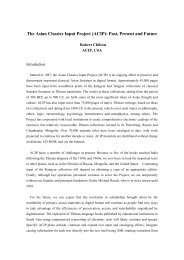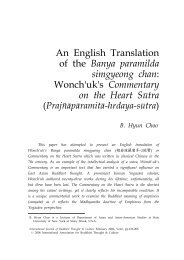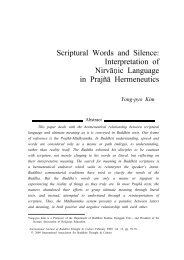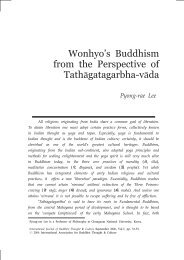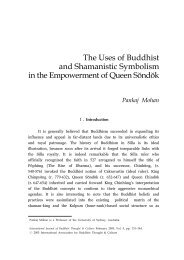Esoteric Buddhism under the KoryÅ in the Light of ... - Buddhism.org
Esoteric Buddhism under the KoryÅ in the Light of ... - Buddhism.org
Esoteric Buddhism under the KoryÅ in the Light of ... - Buddhism.org
You also want an ePaper? Increase the reach of your titles
YUMPU automatically turns print PDFs into web optimized ePapers that Google loves.
International Journal <strong>of</strong> Buddhist Thought & Culture 85<br />
beyond limited sectarian conf<strong>in</strong>es. The fact that <strong>Esoteric</strong> <strong>Buddhism</strong> was<br />
practised with<strong>in</strong> <strong>the</strong> contexts <strong>of</strong> virtually all <strong>the</strong> major Buddhist schools<br />
from <strong>the</strong> middle <strong>of</strong> <strong>the</strong> dynasty and onwards, <strong>in</strong>dicate that its doctr<strong>in</strong>es<br />
and practices can best be <strong>under</strong>stood as part and parcel <strong>of</strong> general<br />
Buddhist beliefs. Undoubtedly it was its rich ritual tradition which made<br />
<strong>Esoteric</strong> <strong>Buddhism</strong> especially attractive to Buddhists throughout <strong>the</strong><br />
country. As far as we know <strong>Esoteric</strong> <strong>Buddhism</strong> did not exist as a<br />
separate school <strong>under</strong> <strong>the</strong> Song, but its practices functioned as a<br />
<strong>under</strong>-current <strong>in</strong> <strong>Buddhism</strong> as a whole much like it did <strong>in</strong> Koryŏ. It is<br />
unclear how <strong>the</strong> situation was <strong>under</strong> <strong>the</strong> Liao and <strong>under</strong> <strong>the</strong> J<strong>in</strong>, but <strong>in</strong><br />
Heian and Kamakura Japan, <strong>the</strong> Sh<strong>in</strong>gon School <strong>of</strong> <strong>Esoteric</strong> <strong>Buddhism</strong><br />
existed as a dist<strong>in</strong>ct and separate Buddhist denom<strong>in</strong>ation, and only<br />
shared some <strong>of</strong> its practices with <strong>the</strong> o<strong>the</strong>r schools <strong>of</strong> <strong>Buddhism</strong>.<br />
No matter <strong>the</strong> type <strong>of</strong> <strong>Esoteric</strong> <strong>Buddhism</strong> which flourished <strong>under</strong><br />
<strong>the</strong> Koryŏ, we have noted a curious absence <strong>of</strong> <strong>Esoteric</strong> Buddhist<br />
iconography <strong>in</strong> <strong>the</strong> surviv<strong>in</strong>g objects <strong>of</strong> Buddhist art from <strong>the</strong> period.<br />
The meagre evidence that exist suggest that <strong>Esoteric</strong> Buddhist<br />
iconography was not particularly widespread if <strong>in</strong>deed well-known on<br />
<strong>the</strong> Korean Pen<strong>in</strong>sula dur<strong>in</strong>g <strong>the</strong> Koryŏ. In any case it is sufficiently<br />
clear that <strong>the</strong> <strong>Esoteric</strong> Buddhist art <strong>of</strong> <strong>the</strong> Koryŏ was not like that <strong>of</strong><br />
Heian Japan <strong>in</strong> which a very rich tradition with roots <strong>in</strong> <strong>the</strong> late Tang<br />
dynasty existed.<br />
Extant data on <strong>the</strong> dh2ra!6-pillars and related material <strong>in</strong>dicate<br />
that <strong>under</strong> <strong>the</strong> Koryŏ beliefs and practices based on a series <strong>of</strong> powerful<br />
dh2ra!6 were widespread, and that Korean Buddhists at that time shared<br />
this belief with Buddhists <strong>in</strong> <strong>the</strong> o<strong>the</strong>r East Asian as well. This is a<br />
good example <strong>of</strong> a cont<strong>in</strong>ental pan-East Asian form <strong>of</strong> Buddhist practice<br />
<strong>in</strong> which <strong>the</strong> Koreans also participated.<br />
Hoguk pulgyo <strong>under</strong>stood as <strong>Buddhism</strong> function<strong>in</strong>g on behalf <strong>of</strong> <strong>the</strong><br />
ruler and <strong>the</strong> k<strong>in</strong>gdom was clearly a reality <strong>under</strong> <strong>the</strong> Koryŏ. It should<br />
not be read as “nationalist” or even “patriotic <strong>Buddhism</strong>,” but that one<br />
<strong>of</strong> <strong>the</strong> roles <strong>of</strong> <strong>the</strong> religion was to carry out special services on behalf



